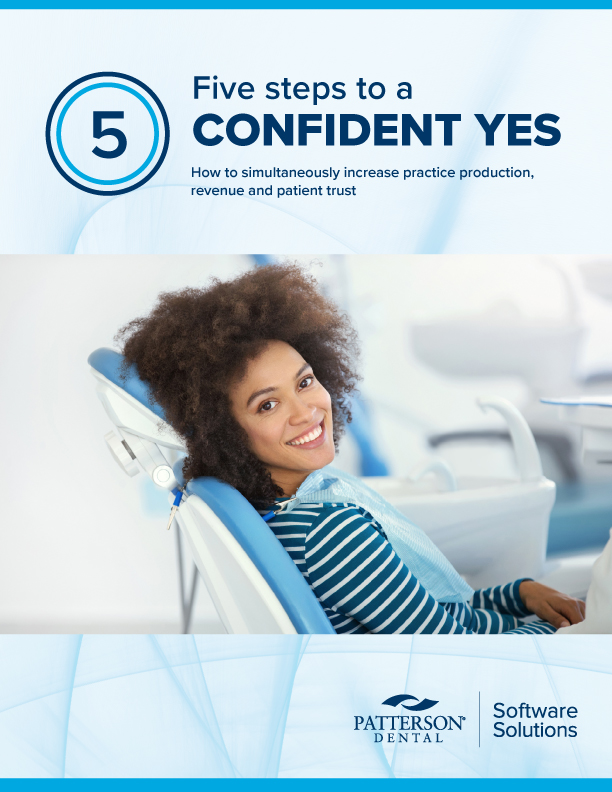Electronic dental records not just wave of future but wave of present
EDRs can meet clinical, business needs

The ability to share and receive information with other dentists, dental specialists and medical providers electronically.
Charting, treatment planning, imaging and accounting all digitized.
And the opportunity to potentially improve patient engagement and outcomes.
That is why the ADA is actively advocating for technology solutions and regulations which meet the needs of ADA member dentists and the larger dental industry.
‘Truly is the current state of the profession’
Hal S. Jeter, D.D.S, is vice president of the Ohio Dental Society and part of a collaborative on medical-dental integration called MORE Care Ohio.
“If you are not already utilizing electronic dental practice management software you need to seriously consider it,” Dr. Jeter said. “It truly is the current state of the profession with regard to imaging and patient record management. As our methods of communication in any realm are largely digitized, the ability to communicate with other health care providers toward a goal of providing a more collaborative and comprehensive mode of patient care is essential. Electronic dental records and electronic communication would allow sharing of imaging, patient lab results, progress notes, treatment plans and other information between providers.”
“Decreasing administrative burdens and paperwork through the streamlining of the prior authorization and claims transaction processes would allow dentists and other health care providers to spend more time and resources taking care of patients,” said Manny Chopra, D.M.D., chair of the ADA Council on Dental Practice.
There is a caveat, though, Dr. Jeter said.
“The challenge to all of that, however, is that there does not yet exist a widely available centralized electronic health record mechanism usable by both medical and dental providers,” he said.
Dr. Chopra echoed the sentiment.
“Ultimately, patient satisfaction and the potential savings for the dental industry will not be actualized unless electronic dental record and practice management systems are required to adopt standards to facilitate electronic data interchange,” he said. “We hope the Centers for Medicare & Medicaid Services will continue to promote interoperability to facilitate the exchange of information between providers, patients and payers, and support a CMS focus on educating, engaging and incentivizing business partners to facilitate the move.”
The marketplace is developing, and decision support tool development needs to have much better data, particularly when looking at medical-dental interrelationships, said Mark Jurkovich, D.D.S., who currently leads the International Health Terminology Standards and Development Organization’s Dentistry Clinical Reference Group.
“Dental EHRs may need to change compared to EHRs used by our medical colleagues,” he said.
The ADA is leading the conversation on electronic dental records through the efforts of the ADA Standards Committee on Dental Informatics, whose 400 volunteers from the profession, industry, academia and government contribute their expertise to the development of ADA SCDI dental standards through a consensus-based process fully accredited by the American National Standards Institute.
The SCDI has developed standards under four general subjects: information exchange, clinical informatics, knowledge management and forensic odontology informatics. Additionally, the SCDI is reviewing the data exchanged and processes used by electronic administrative transactions.
“The ADA SCDI produces standards which form the foundation for uniform data that allows interoperability among dental and medical systems,” said Gregory Zeller, D.D.S., chair of the SCDI Subcommittee on Clinical Informatics. “The SCDI also forms partnerships with medical Standards Development Organizations, such as HL7 and DICOM, to help assure that elements of standards which are common both to dental and medical are uniformly applied while accommodating in the shared standards those unique elements pertinent to either area.”
ADA efforts to ease technology burdens
There are barriers to the successful adoption and use of electronic records. Often the costs for new technology, the effort of switching from paper records to digital, or the time and resources needed to train staff on new systems can be daunting for many practices.
The ADA recently conducted a nationwide survey of U.S. dental offices in order to understand the use of electronic health/dental records and associated issues, such as the ability to transfer data between systems and the ability to share information with other dental and medical providers electronically.
The survey, “Provider Perspectives on Health Information Technology in the Dental Office,” is providing the ADA with information that will aid in the development of policies and advocacy efforts to improve the impact of health information technology on practices. The providers who participated shared critical information as the ADA navigates its interactions with federal regulators and promotes polices that support dental practices.
“It’s critically important that we understand from practicing dentists how dental practice management software and electronic dental records impact [their] business operations and clinical care in their practices and how the ADA can best advocate for dentistry,” said Michael Saba, D.M.D., chair of the Digital Dentistry, Technology and Innovation Subcommittee of the ADA Council on Dental Practice.
ADA advocacy continues
The ADA has communicated as recently as late June with the federal government about interoperability and adoption of standards for health IT that would make it more amenable to dentists
ADA President George R. Shepley, D.D.S., and ADA Executive Director Raymond A. Cohlmia, D.D.S., in June 20 comments on a proposed rule to Secretary Xavier Becerra of the U.S. Department of Health and Human Services, commended the department and its Office of the National Coordinator for Health Information Technology for continuing to promote interoperability, and for adopting new standards that take the needs of dentistry into account. However, they also pointed out that Office of the National Coordinator for Health Information Technology would need to do more to take the differences between medical and dental practice into account, including ensuring there is dental representation on the Health Information Technology Advisory Committee.
In March 13 comments to Chiquita Brooks-LaSure,Centers for Medicare & Medicaid Services administrator, Dr. Shepley and Amr M. Moursi, D.D.S., Ph.D., American Academy of Pediatric Dentistry president, thanked CMS for continuing to promote interoperability to facilitate the exchange of information between providers, patients, and payers in its proposed rule. The proposals would implement changes intended to improve patient and provider access to health information and streamline processes related to prior authorization for medical items and services .
“However, to both improve the prior authorization process and promote interoperability, CMS must take the different needs of dental practices and medical practices into account,” Drs. Shepley and Moursi wrote. “Further, this proposal will be much more effective for dental data exchange if CMS focuses on educating, engaging, and incentivizing business partners to facilitate the move toward adoption of the standards discussed in this rule. Administrative efficiency can only be achieved if we have robust standards which are inclusive of specialties and small practices, and if all business partners use these standards to communicate information.”
In March 20 comments to Administrator Brooks-LaSure on a proposed rule implementing standards for electronic attachments sent between health IT systems,,Drs. Shepley and Cohlmia wrote in response to a proposal about explanation of benefits calculations, “As CMS helpfully notes, technology that can facilitate fully electronic transactions has not been widely adopted in the world of dentistry. In an ideal world, dental offices would request and receive information in real-time regarding a patient’s eligibility under a dental plan and information on the availability of benefits, i.e., coverage and cost on specific procedures on specific dates of service down to the individual procedure/tooth level. This information would then be provided to the patient, thus avoiding unanticipated charges following treatment.”
Drs. Shepley and Cohlmia said that according to a 2020 CAQH report, the potential savings from properly implemented fully electronic transactions would be more than $760 million for eligibility transactions. But, “unfortunately, we are far from this ideal world.”
“The ADA commends CMS for its focus on adoption of standards that would streamline the prior authorization process, as well as other transactions involving attachments,” said Dr. Shepley and Dr. Cohlmia, who added, “The ADA strongly supports incentives and significant investment in dental-specific electronic transaction pilots and technology to move the dental industry towards real-time exchange and burden reduction.”
Implementation, over the long run, is well worth the initial fears, said Dr. Jeter.
“Once the ‘newness’ has passed it truly becomes an asset that you wonder how you ever lived without,” he said.



